I think one of the most important things to learn right away is intervallic relationships such as minor, perfect, major, augmented, diminished, as well as octaves. Additionally, it’s a good idea to know the structure of the Major scale and other diatonic scales, as well as what a triad and a 7th chord are.
There are a ton of chord progressions that will work and sound great, many of which are theoretically “incorrect” as well. Before we dive into the creation of the major and minor scale chords, I’m going to offer up a fairly big list of common chord progressions that should keep you busy for a while.
Some of these are very old progressions, and some of them are more modern. The great thing about each one is that you can add or subtract whatever notes/chords you want to them and create something entirely new. I’ve also included all the chords in every key in Major, Minor, Harmonic Minor, and Melodic Minor scales.
Generally speaking, an easy to determine if chords go together is to look at the Circle of Fifths. One way is to use relative major and minor chords. Additionally, choose any chord as your I chord, and then count left or right by 4 or 5 degrees, and you’ll get a chord that works with that key.
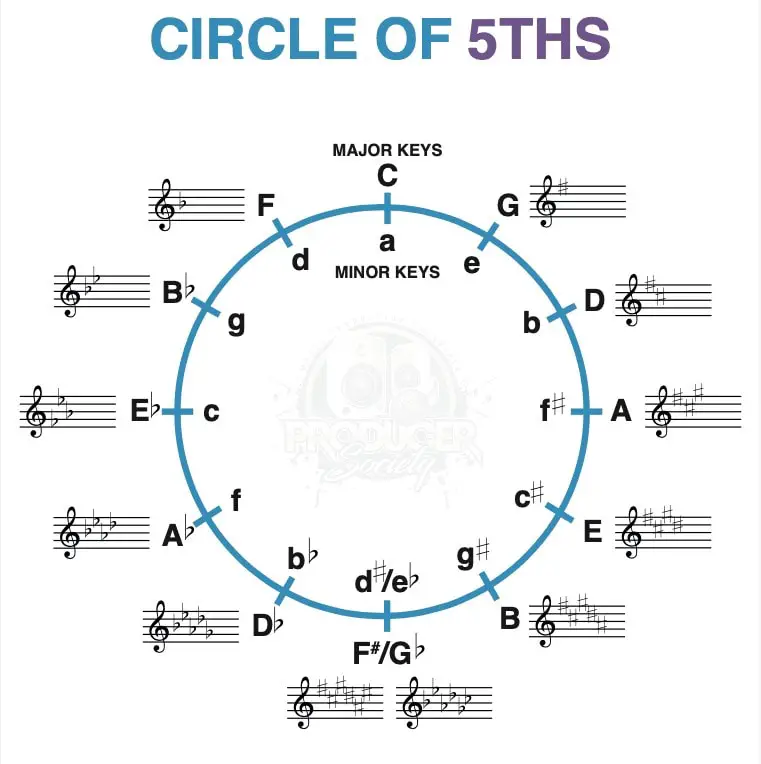
Some other chords that sound good together are the following:
1. F, B♭ and C
2. C, Am, F, G – 50s Progression
3. C, F, Bb, F
4.. C♯m, E, B and A
5. F♯m, B and C♯
6. Am, G, F, E – Andalusian Cadence
7. E, A, and B
8. Dm, Bb7, C – Backdoor Progression
9. D, A, B and G
10. A, E, G, D – Chromatic Descending
11.. E, B and G
12. Am6, Dm, G6, C – Circle Progression
13. D, Am7 and G
14. C, G7, F7, F7, C7, G7, C7, G7 – 8 Bar Blues
15. C, G, F and Am
16. G, C, D and Em
17. B, A G F♯
18. D, A, C and G
19. Dm, F and C
20. D, C, B♭ and F
21. Dm, G, C – Common Jazz Progression (ii, V, I)
22. D, A and G (drop D version)
23. A, D and E
24. D, C and G
25. D, G, Bm and A
26. C7, F7, Dm7, G
27. E, B, C♯m, G♯m and A
28. D, F, G, C and G
29. D, A, G and Em
30. Em, G, D, C and A
31. D, E♭ and F (drop D)
32. Asus2, E, B and G
33. Am7, Dm7, G7 and Cm7
34. C, G, Am, F
35. F♯m7, B7, E and A
36. G7, C, C9, Dm7 and C
37. F, Em, Am, G and Am
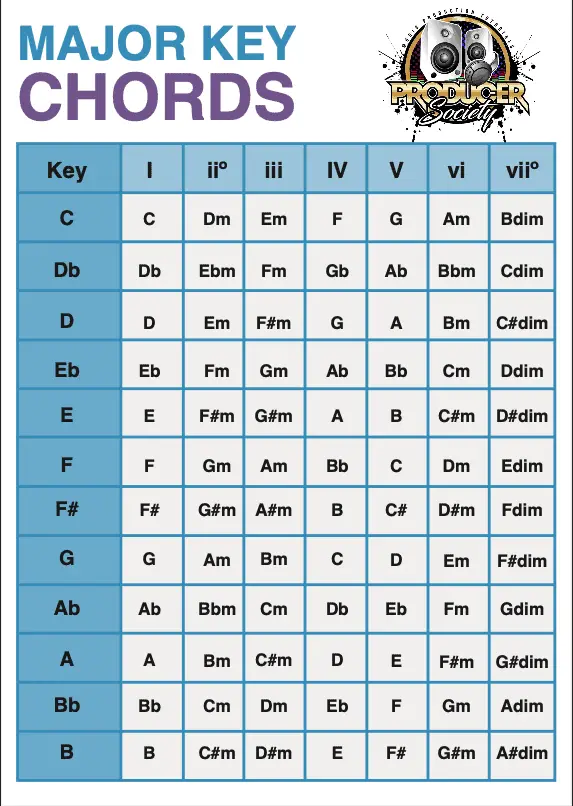
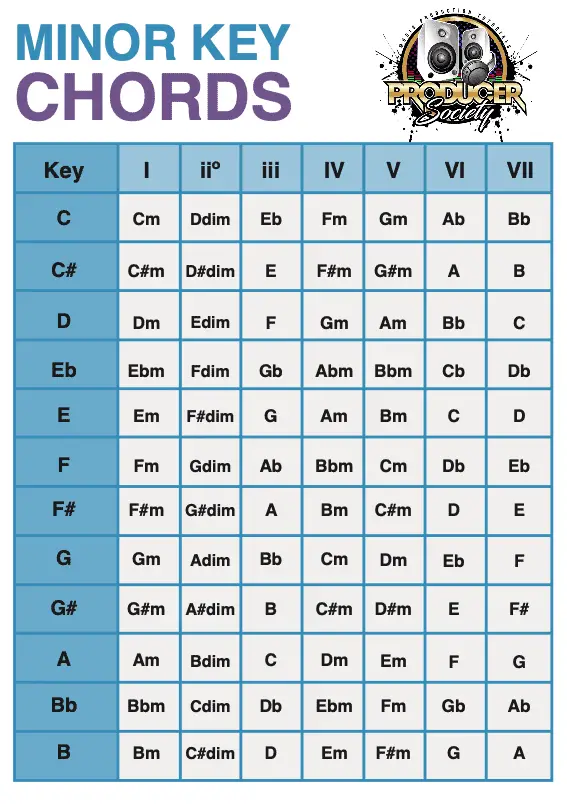
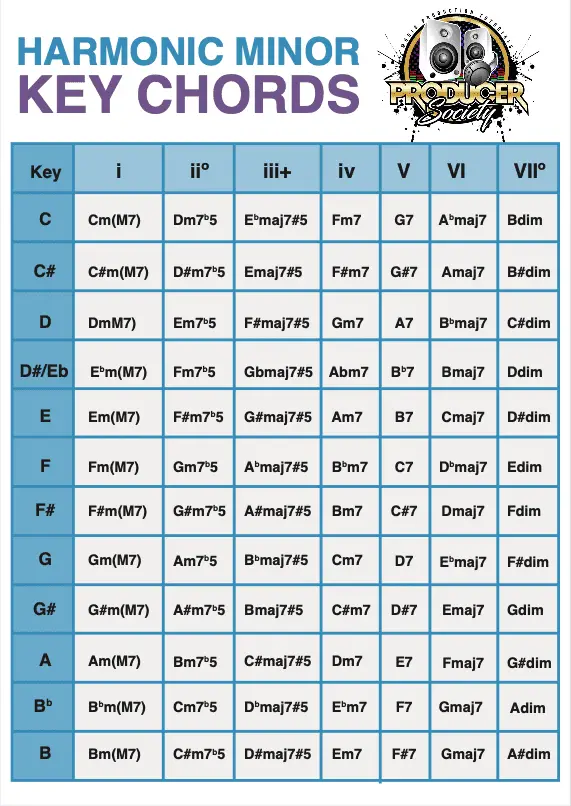
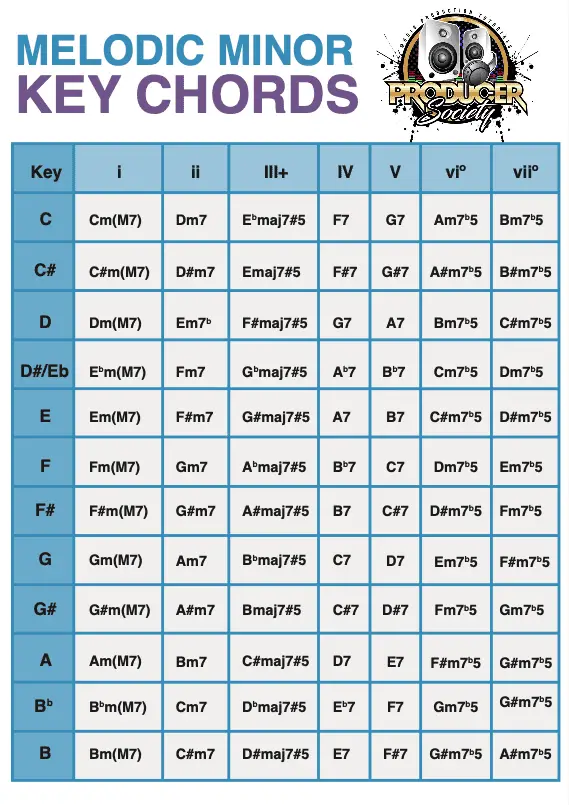
The Notes And Chords Of The Major Scale
The purpose of this section is to give you a guideline for understanding why some chords seem to go better together than others.
Moreover, understanding the notes of the major scale as well as the chords will help you become a better player and a more informed musician in general. It has the added benefit of helping your improvisation skills as well.
Right away, we should start off by outlining the notes and chords of the C Major Scale which are the following:
C, D, E, F, G, A, B, and C again.
Those are the notes of the C Major scale.
The chords of the major scale are the following:
I, ii, iii, IV, V, vi, viiø
The large Roman numerals (I) mean that the scale degree is major, the lower-case (i) Roman numerals mean that the scale degree is minor and then the lower-case Roman numeral with the little ‘ø’ beside it means that it’s a diminished triad.
There is also the 3 chord in the minor scale, III+, which means that it’s augmented, in addition to other chords that have the little ‘7’ over top of it, which signifies that it’s a dominant 7th chord.
Let’s construct triad chords using the notes of the C Major scale.
I, ii, iii, IV, V, vi, viiø
C Major = I
D Minor = ii
E Minor = iii
F Major = IV
G Major = V
A Minor = vi
B Half-Diminished = viiø

What’s a Triad?
A triad is a chord that’s made up of three notes, the root, the third, as well as the fifth.
And what you do to create one, is you simply take every other note of the scale and build a chord out of those three notes.
For instance, you have the C Major scale listed above, so here are the chords outlined above, in addition to the actual notes that make up each one.
C Major = I = C E G
D Minor = ii = D F A
E Minor = iii = E G B
F Major = IV = F A C
G Major = V = G B D
A Minor = vi = A C E
B Half-Diminished = viiø = B D F
These are the chords of the C Major scale. Truthfully, there is a way to use every single one of those chords in a progression and make them sound good, however, some combinations will sound a lot better than others.
For instance, perhaps the most common progression is the I-IV-V progression, which is the first, fourth, and fifth chords.
Most Top 40 songs re-use the most popular chord progressions over and over again, especially in the modern era.
There was a time when hit songs were more harmonically complex, but it seems that in the modern era, the most popular songs are attempting to reach a much wider audience.
For that reason, songwriters try to make their tracks as simple as possible, that way there is no room for unusual melodies or sounds that audiences won’t enjoy.
The Notes And Chords Of The Minor Scale
For this, we’re going to use the relative minor of the C Major scale, A Minor. The relative minor of a major scale is always built upon the sixth note of the sixth scale degree of the Major Scale.
“Relative Minor” means that it basically uses the exact same notes, but they’re ordered in a different way, which creates an entirely different sound and purpose.
i – A Minor
iiø – B Diminished
III – C Major
iv = D Minor
v = E Minor
VI = F Major
VII = G Major/G Dominant 7th
Let’s elaborate on this further, by using the aforementioned relative minor of the C Major scale, A Minor.
A Minor Scale and Its Chords
A Minor = i = A C E
B Diminished = iiø = B D F
C Major = III = C E G
D Minor = iv = D F A
E Minor = v = E G B
F Major = VI = F A C
VII = G Major/G Dominant 7th = G B D (F)
From this scale, similar to the one laid out above, you could go through and use any one of those chords and make it sound good, although, some would definitely sound a lot better than others.
The great thing about music is that there really is no limit to what can be done because there are a ton of permutations that can be used.
The real issue, however, is that as songs and progressions become more harmonically complex, the potential audience for it to reach is much smaller, and thus, less likely to be a hit song.
Additionally, there are way more scales that one can use as well, including the Harmonic Minor and Melodic Minor scales, as well as the mode of each scale.
If you check out my article on Producer Society, How to Use Modes, Modes Explained For Garageband, I run through how you can use the modes of the major and minor scales.
It’s really quite amazing what one can do. However, this article isn’t about modes, it’s about building common chord progressions that’ll sound good to the average person’s ear.
As an added note, you can create arpeggios out of each one of those chords. In my view, it’s definitely worth your time to learn how to play arpeggio shapes of the Major, Minor, Major 7, Minor 7, Dominant 7, and Diminished chords, which are then movable in every single key signature.
This is very useful for improvising.
Why Do Certain Chords Sound Good With Others
The reason why chords sound together has to do with intervallic relationships between notes and how they sound in conjunction with the others.
For instance, if one is in the Key of C Major, there are particular intervals within the scale, that are also built into the chords, so when you play those chords together in combination with each other, the intervals just end up meshing well together.
This is, of course, a very basic explanation of why they sound good together. In the future, maybe I’ll write a full tutorial and explanation on why some chords sound good and others don’t.

Other Articles You May Be Interested In
- How to Harmonize in 3rds (Major and Minor) on Guitar [EASY]
- 7 Reasons Why Learning To Play The Guitar Is Not That Hard
- What’s A B7 Chord + (And How Do You Play It?)
- How to Use the MXR Clone Looper Pedal [Full Tutorial]

 Written By :
Written By :
